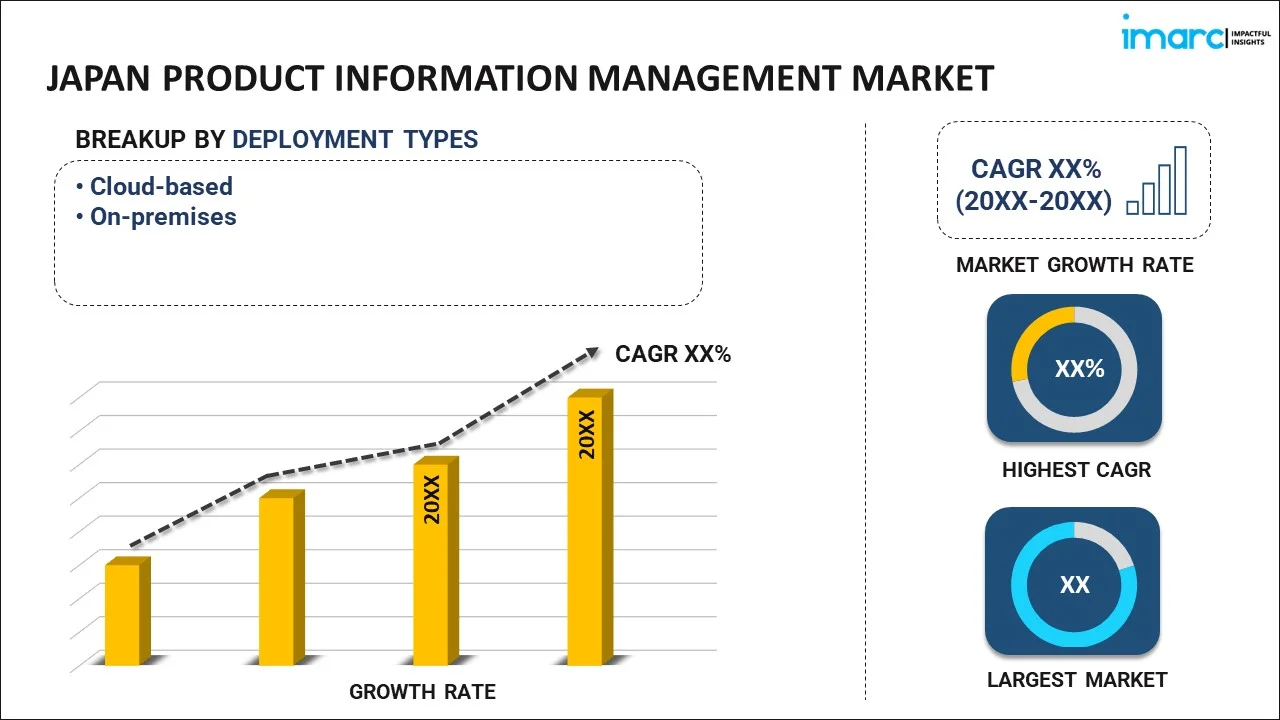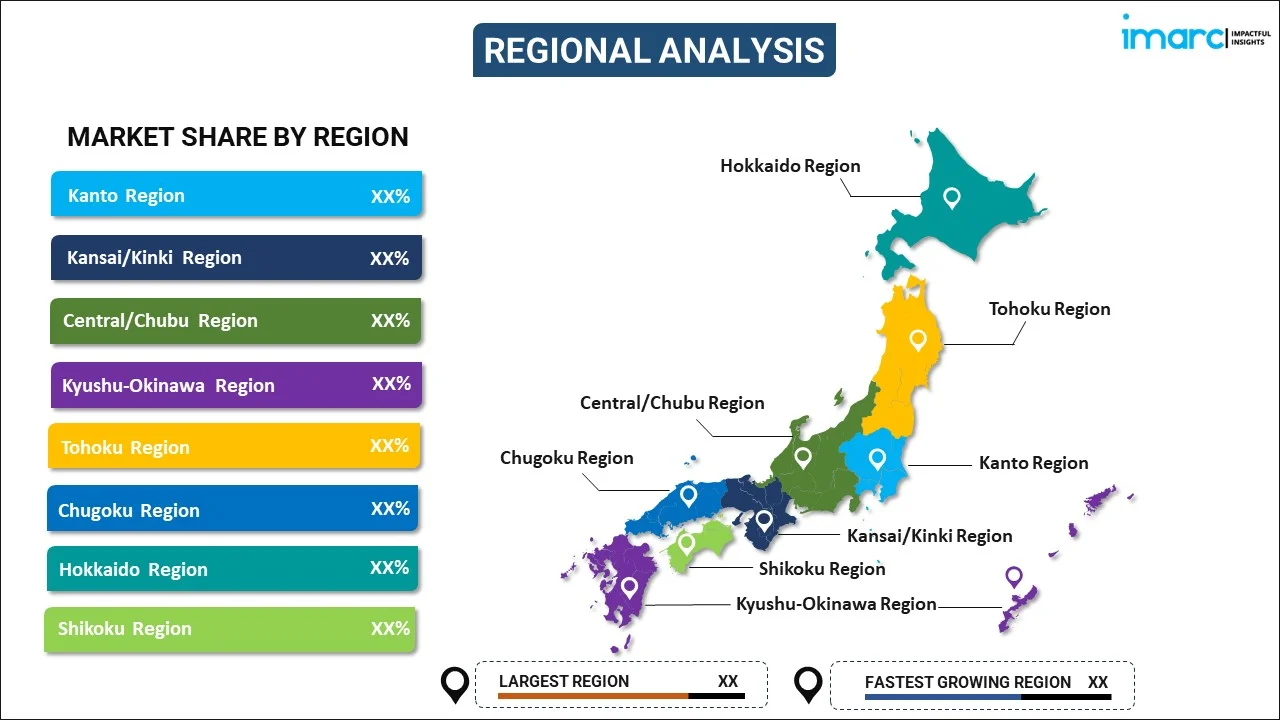
Japan Product Information Management Market Report by Deployment Type (Cloud-based, On-premises), Component Type (Software, Services), Organization Size (Small and Medium Enterprises, Large Enterprises), Vertical (BFSI, Manufacturing, Retail, Healthcare, IT and Telecom, Logistics and Transportation, Travel and Hospitality, and Others), and Region 2025-2033
Market Overview:
The Japan product information management market size reached USD 852.0 Million in 2024. Looking forward, IMARC Group expects the market to reach USD 2,515.0 Million by 2033, exhibiting a growth rate (CAGR) of 12.8% during 2025-2033. The significant expansion in the online retail and e-commerce industry, the widespread adoption of product information management (PIM) in the healthcare and pharmaceutical industries, and the increasing product application in the manufacturing sector represent some of the key factors driving the market.
|
Report Attribute
|
Key Statistics
|
|---|---|
|
Base Year
|
2024 |
|
Forecast Years
|
2025-2033
|
|
Historical Years
|
2019-2024
|
| Market Size in 2024 | USD 852.0 Million |
| Market Forecast in 2033 | USD 2,515.0 Million |
| Market Growth Rate (2025-2033) | 12.8% |
Product information management (PIM) is an essential aspect of modern business operations, particularly in the context of e-commerce and product-driven industries. It refers to the process of centrally managing and organizing product data and information to ensure accuracy, consistency, and accessibility across various channels and platforms. It serves as a hub where businesses can collect, enrich, and distribute product-related data to effectively market and sell their products, including details such as product descriptions, specifications, images, pricing, and availability. PIM systems gather product information from numerous sources within an organization, including enterprise resource planning (ERP) systems, spreadsheets, and databases allowing businesses to avoid data silos and ensure that everyone accesses the same, up-to-date information. Additionally, it allows for the enrichment of product data with additional attributes, including translations, categorizations, and marketing content, which ensures that products are presented in a compelling and consistent manner across various sales channels. It also enforces consistency by standardizing product information, which is essential for building customer trust and ensuring a seamless shopping experience. Nowadays, PIM enables businesses to efficiently distribute product data to various sales channels, including websites, marketplaces, and catalogs, to streamline the process of listing and updating products across different platforms.
Japan Product Information Management Market Trends:
The market is primarily driven by the growing e-commerce sector in Japan due to changing consumer preferences, growing internet penetration, and the convenience of online shopping. In addition, businesses embrace online retail, and the need to manage vast product catalogs led to the adoption of PIM solutions, providing a centralized platform to manage and update product information across numerous online channels, ensuring consistency and enhancing the customer experience, influencing the market growth. Moreover, the widespread adoption of product information management in the manufacturing sector to manage and share product data with distributors, suppliers, and other partners while streamlining product development and collaboration ensures the supply chain access to accurate and consistent information, representing another major growth-inducing factor. Besides this, the rising demand for product information management in the consumer electronics industry deals with various products, each with its own specifications and features, and helps manage complex product data, ensuring that accurate information is available for marketing, sales, and customer support, accelerating market growth. Along with this, the growing fashion and apparel industry is using product information management to maintain consistency in product listings across numerous platforms and channels regarding sizes, colors, and materials, propelling the market growth. Furthermore, the extensive product use in the healthcare and pharmaceutical industries helps manage product data, labeling, and documentation to ensure compliance and patient safety, creating a positive market outlook.
Japan Product Information Management Market Segmentation:
IMARC Group provides an analysis of the key trends in each segment of the market, along with forecasts at the country level for 2025-2033. Our report has categorized the market based on deployment type, component type, organization size, and vertical.
Deployment Type Insights:

- Cloud-based
- On-premises
The report has provided a detailed breakup and analysis of the market based on the deployment type. This includes cloud-based and on-premises.
Component Type Insights:
- Software
- Single Domain
- Multi-Domain
- Services
- Consulting and System Integration
- Training, Support and Maintenance
A detailed breakup and analysis of the market based on the component type have also been provided in the report. This includes software (single domain and multi-domain) and services (consulting and system integration and training, support and maintenance).
Organization Size Insights:
- Small and Medium Enterprises
- Large Enterprises
The report has provided a detailed breakup and analysis of the market based on the organization size. This includes small and medium enterprises and large enterprises.
Vertical Insights:
- BFSI
- Manufacturing
- Retail
- Healthcare
- IT and Telecom
- Logistics and Transportation
- Travel and Hospitality
- Others
A detailed breakup and analysis of the market based on the vertical have also been provided in the report. This includes BFSI, manufacturing, retail, healthcare, IT and telecom, logistics and transportation, travel and hospitality, and others.
Regional Insights:

- Kanto Region
- Kansai/Kinki Region
- Central/ Chubu Region
- Kyushu-Okinawa Region
- Tohoku Region
- Chugoku Region
- Hokkaido Region
- Shikoku Region
The report has also provided a comprehensive analysis of all the major regional markets, which include Kanto Region, Kansai/Kinki Region, Central/ Chubu Region, Kyushu-Okinawa Region, Tohoku Region, Chugoku Region, Hokkaido Region, and Shikoku Region.
Competitive Landscape:
The market research report has also provided a comprehensive analysis of the competitive landscape. Competitive analysis such as market structure, key player positioning, top winning strategies, competitive dashboard, and company evaluation quadrant has been covered in the report. Also, detailed profiles of all major companies have been provided.
Japan Product Information Management Market Report Coverage:
| Report Features | Details |
|---|---|
| Base Year of the Analysis | 2024 |
| Historical Period | 2019-2024 |
| Forecast Period | 2025-2033 |
| Units | Million USD |
| Scope of the Report | Exploration of Historical Trends and Market Outlook, Industry Catalysts and Challenges, Segment-Wise Historical and Future Market Assessment:
|
| Deployment Types Covered | Cloud-based, On-premises |
| Component Types Covered |
|
| Organization Sizes Covered | Small and Medium Enterprises, Large Enterprises |
| Verticals Covered | BFSI, Manufacturing, Retail, Healthcare, IT and Telecom, Logistics and Transportation, Travel and Hospitality, Others |
| Regions Covered | Kanto Region, Kansai/Kinki Region, Central/ Chubu Region, Kyushu-Okinawa Region, Tohoku Region, Chugoku Region, Hokkaido Region, Shikoku Region |
| Customization Scope | 10% Free Customization |
| Post-Sale Analyst Support | 10-12 Weeks |
| Delivery Format | PDF and Excel through Email (We can also provide the editable version of the report in PPT/Word format on special request) |
Key Questions Answered in This Report:
- How has the Japan product information management market performed so far and how will it perform in the coming years?
- What has been the impact of COVID-19 on the Japan product information management market?
- What is the breakup of the Japan product information management market on the basis of deployment type?
- What is the breakup of the Japan product information management market on the basis of component type?
- What is the breakup of the Japan product information management market on the basis of organization size?
- What is the breakup of the Japan product information management market on the basis of vertical?
- What are the various stages in the value chain of the Japan product information management market?
- What are the key driving factors and challenges in the Japan product information management?
- What is the structure of the Japan product information management market and who are the key players?
- What is the degree of competition in the Japan product information management market?
Key Benefits for Stakeholders:
- IMARC’s industry report offers a comprehensive quantitative analysis of various market segments, historical and current market trends, market forecasts, and dynamics of the Japan product information management market from 2019-2033.
- The research report provides the latest information on the market drivers, challenges, and opportunities in the Japan product information management market.
- Porter's five forces analysis assist stakeholders in assessing the impact of new entrants, competitive rivalry, supplier power, buyer power, and the threat of substitution. It helps stakeholders to analyze the level of competition within the Japan product information management industry and its attractiveness.
- Competitive landscape allows stakeholders to understand their competitive environment and provides an insight into the current positions of key players in the market.
Need more help?
- Speak to our experienced analysts for insights on the current market scenarios.
- Include additional segments and countries to customize the report as per your requirement.
- Gain an unparalleled competitive advantage in your domain by understanding how to utilize the report and positively impacting your operations and revenue.
- For further assistance, please connect with our analysts.
 Inquire Before Buying
Inquire Before Buying
 Speak to an Analyst
Speak to an Analyst
 Request Brochure
Request Brochure
 Request Customization
Request Customization




.webp)




.webp)












